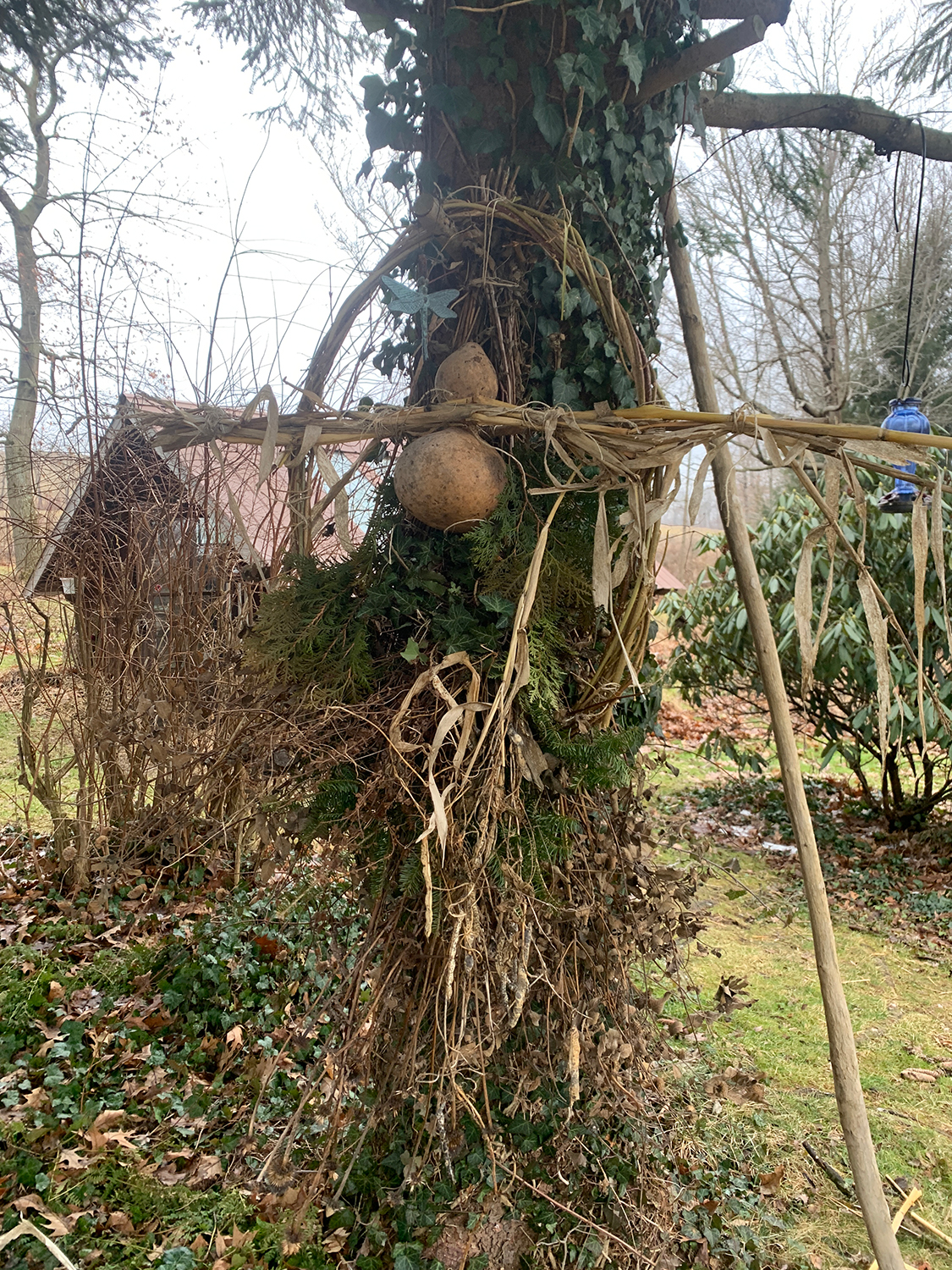
For the last three years, I’ve spent part of my Imbolc celebration making a Butzemann for our land. The Butzemann is a really interesting tradition from PA Dutch (German) culture called the Butzemann (literally, Boogieman). In a nutshell, the Butzemann is a magical scarecrow that protects the land for a season. He is created at Imbolc from natural materials and given clothes and a heart. At the Spring Equinox, the Butzemann is shown the property and the breath of life is breathed into the Butzemann, naming him/her for the season. Then the Butzemann is displayed prominently throughout the season to protect the and. Before or on Samhain, the Butzemann is burned and the protective spirit is released and then at Imbolc, a new tradition begins. Today I thought I’d share this tradition with my readers, in case they also wanted to build this tradition into their celebrations. The time is right to start thinking about creating your Butzeman for the coming season!
As I mentioned, this tradition comes to me from a few sources: the Pennsylvania Dutch heritage that is part of my ancestry, talking with local people about how they construct scarecrows in my region, and also some of the fabulous research of the Urglaawe community, who have been working tirelessly to develop a PA Dutch heathenry and who have done much research on the folk traditions surviving in Pennsylvania.
Pennsylvania is a very magical land. With the founding of Pennsylvania, William Penn offered more religious tolerance than could be found in most parts of Europe during the colonial era. Thus, we had large groups of Germans (PA Dutch or PA Deutsch) among other radicals like Quakers and Shakers settle in Pennsylvania. As you drive through Pennsylvania, it is not uncommon to see pentacles and pentagrams protecting houses or hex signs on barns. Even as you drive through the countryside, you can often see the scarecrows (Butzemann) in the fields, homemade and protecting the crops. And of course, we have the most famous weather prognosticator in the land: Punxatawney Phil, the magical groundhog! These traditions were passed on in small ways through my grandmother to me, and I’m proud to continue them as part of my own spiritual path.
When the Butzemann tradition was taking root in Pennsylvania and being adapted from the old world, most of the people living here were farmers or depended in part on raising their own animals and growing their own food to feed themselves. Having a blight strike the crops, having animals sicken and die, or having a drought could be the difference between thriving and starvation during the long winter months. Given this, doing magical work to protect the home, the land, the crops, and the animals was central. Even if you don’t have crops or farm animals to protect, you can certainly create a Butzemann to protect your home or place of dwelling. As a homesteader with many bird flocks and gardens, this tradition is an extremely important one to my own practice and something I do every year.
In my own research, I have found that the Butzemann tradition has many different varieties here in Pennsylvania. In speaking with several of my German friends from Germany, I have also been told that this tradition has a number of approaches in Germany. One of my German friends told me that I could certainly make a “Butzefrau” (a female Butz) if I preferred–so I’ve included instructions for both.
Imbolc: Constructing your Butzemann or Butzefrau
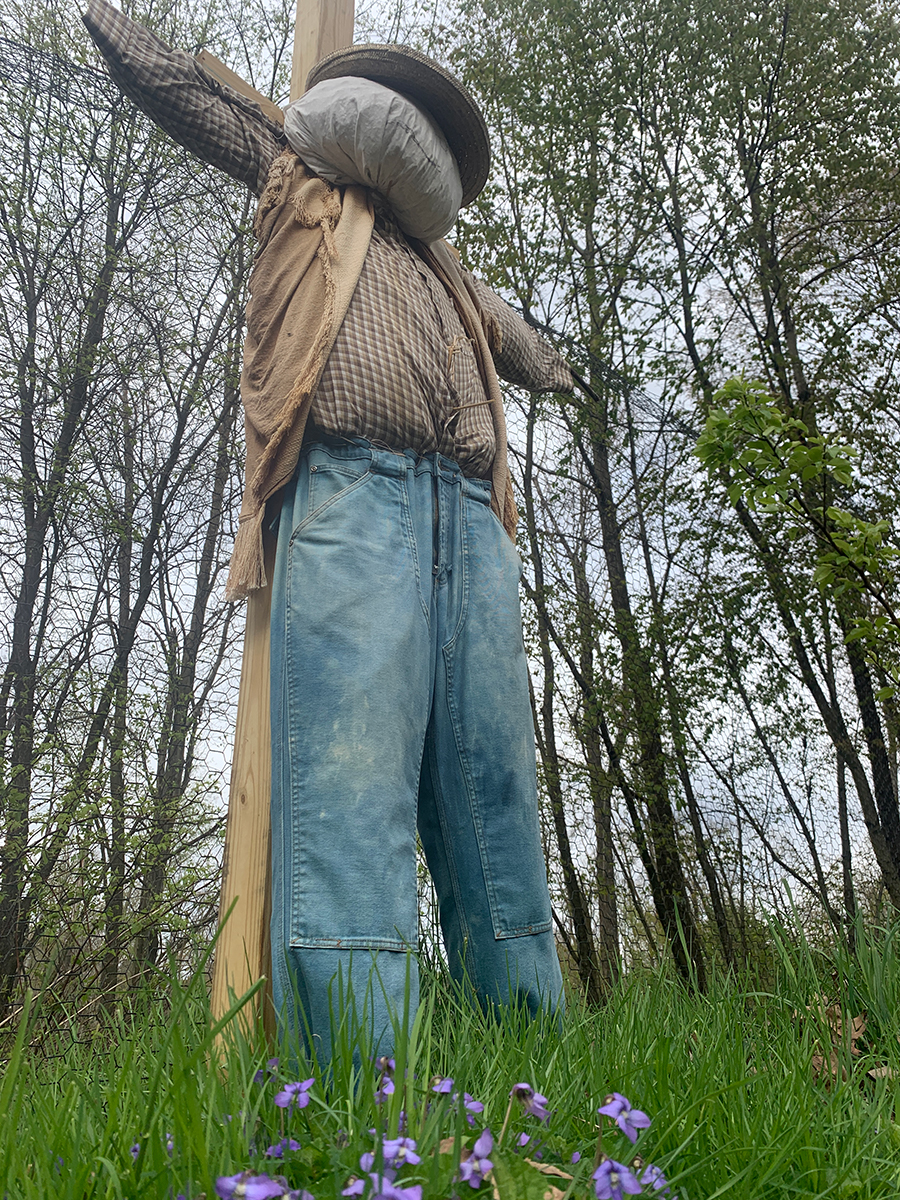
The first step is to construct your Butzemann at Imbolc. I like to go through the woods and our fields and glean dried grasses, corn cobs, gourds, and so forth to make my Butzemann. Sometimes, I gather these in the period between Samhain and the Winter solstice if I feel led, or sometimes I just gather them in the week or so leading up to Imbolc. This includes anything leftover from the garden, straw, etc. You can also create a lifesize Butzemann by sewing old clothing shut and then stuffing your entire Butzemann with straw. This kind of Butzemann looks great watching over a garden! Really, there is no right or wrong way to construct your Butzemann except you want to explicitly use materials from the land where the Butzemann will be protected if at all possible and everything should be natural so that it can burn.
Here are some of the features of a traditional Butzemann as you are constructing yours at Imbolc:
- The Butzemann is constructed or filled with herbs, leaves, straw, sticks, and other natural materials from the land over which they will protect. This is very important–they must be physically connected and constructed from the specific land.
- The Butzemann is given clothing (regular size or smaller that you sew) out of natural materials that can burn. You can also give them a hat. Remember that all of the clothes on the Butzemann are burned at Samhain, so keep this in mind. The clothing is the first “gift” to the spirit who will reside in the Butzemann.
- The Butzemann is given a heart (I like to use a dried nut or acorn for this) to help bring the Butzemann to life. You can put additional symbols, sigils, or words on the heart to assist the Butzemann.
- If you want, you can put other things in the Butzemann (runes, ogham, prayers, slips of paper, and so forth) to help with protective magic and enchantment.
- The Butzemann should have some representation of eyes, ears, a nose, and a mouth. This helps them have all of their senses, which is necessary for protecting the flocks, home, or land that they are placed on to guard.
As you are creating your Butzemann, a name may come to you. Or, it may come later as we approach the Spring Equinox. At this point, the Butzemann is not yet a magical creation–it is just the shell.
Spring Equinox: The Breath of Life and Protecting the Land
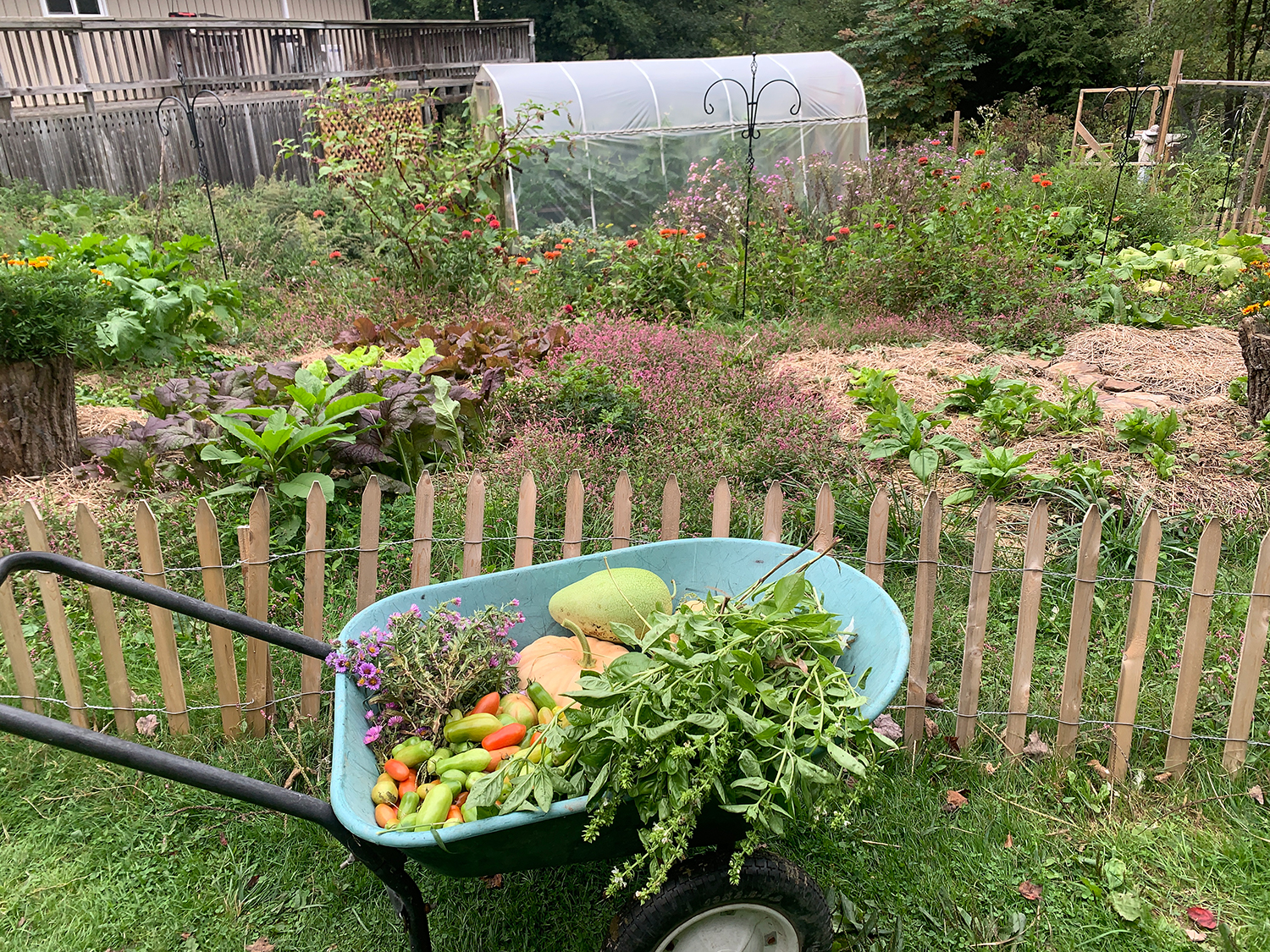
The Spring Equinox is the time where the breath of life is breathed into the Butzemann and where he goes from being a simple shell to a house for a protective spirit that will guard your land for the coming season.
The first thing that is done is that the Butzemann is ritually named and a good, protective spirit is welcomed in. You can create your own ritual for this or you can use this one from the Urglaawe community. The steps of the ritual are:
- Open up a sacred space (being aware you will be moving through your property so make it large enough to do so)
- Breathe life into the Butzemann (literally breathe or blow on the Butzemann); this invites a good spirit to enter and stay for the season
- Give the Butzemann a name (see naming, below)
- Close the space.
As the second part of your ritual, you should walk your Butzemann around the property they are to guard. Then, place them somewhere prominently so that he can see the area they aree to guard clearly. It is good to make regular offerings to your Butzemann, speak to them by name, and visit them as the season progresses. This helps establish reciprocation between you and the guardian spirit of the Butzemann.
Naming conventions for both Butzemann and Butzefrau
The Butzemann tradition has some very specific naming conventions. Each generation of Butzemann you create takes not only his/her own name, but the names of his/her predecessors. The naming conventions are a bit tricky, so I suggest looking at this link for more detailed information. In a nutshell, the first generation will have a name with “der Nei” indicating the first. Everything after the first generation (each year you create a Butzemann) will have additional names and the first generation name.
If you are working to create Butezmann you would use “san” (the family name, which is likely a derivation of “son”). This is the traditional way. Example:
- Year 1: Gerania der Nei
- Year 2: Thyme Gerania Geraniasan
- Year 3: Sage Thyme Gerania Geraniasan
- Year 4: Parsley Thyme Gerania Geraniasan
I consulted with my German friend, and she thinks that “San” is likely a derivation of “Son of” and may not be appropriate for Butzefrau. Thus, if you are making a female Butz you would want to use “docha”. So this would look like this:
- Year 1: Gerania der Nei
- Year 2: Thyme Gerania Geraniadocha
- Year 3: Sage Thyme Gerania Geraniadocha
- Year 4: Parsley Thyme Gerania Geraniadocha
Samhain: The Burning

At or before Samhain, your Butzemann must be burned. At Samhain, the Butzemann’s spirit will leave and if you do not burn it, a bad spirit may take up residence. Thus, you should burn your Butzemann before the end of Astrological Samhain. I like to build a sacred fire as part of my Samhain festivities. When it is time to burn the Butzemann, I begin by scattering some of the season’s herbs into the fire as an offering, also sharing my gratitude and thanks. I carefully place the Butzemann on the fire and watch the Butzemann burn. This is always a very magical experience to watch the Butzemann burn–it burns in such interesting ways. I put the ashes in the garden, and wait for Imbolc to return.
The Cycle Begins Again
After Samhain, we reach the full cycle of the Butzmann tradition. The flocks are snug in their coops while the snows fall, and the land once again falls asleep. But as soon as the sugar maples start running, the Butzmann tradition can be born. Since we started doing a Butzemann here on our homestead, we have noticed a difference: less challenges with predators, abundant harvests even through a drought, and a general presence on the land that supports everything we do. I think this is a wonderful tradition to start and continue, and I hope some of you will consider it!
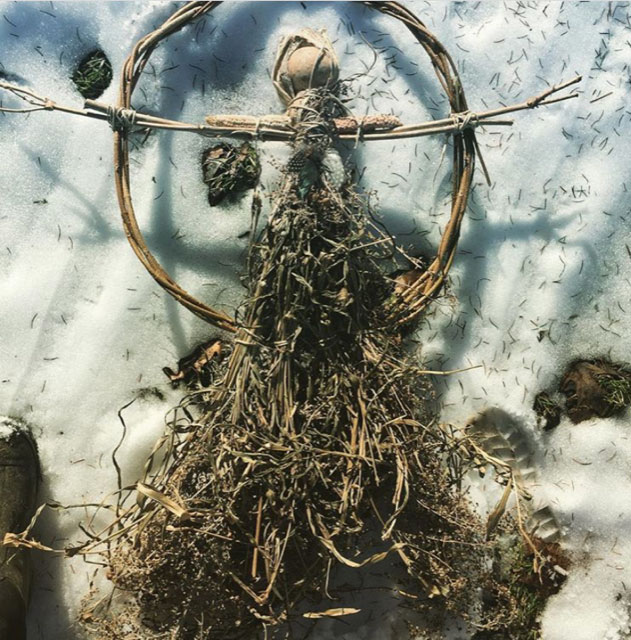
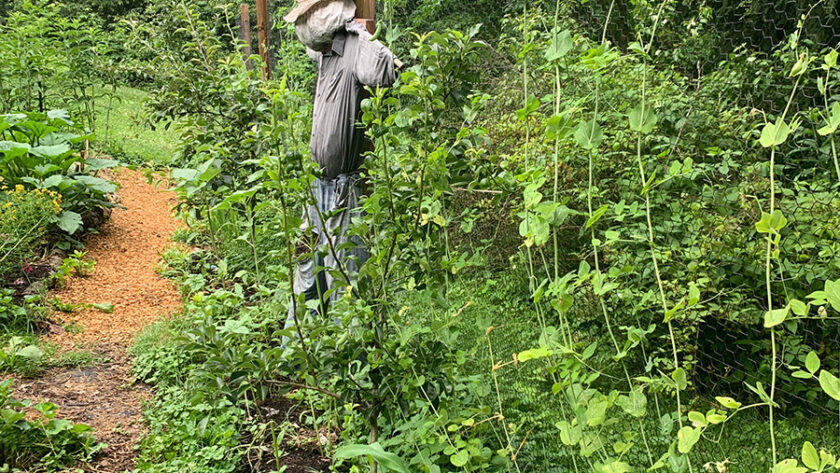



Reblogged this on Paths I Walk.
I enjoyed this article. I lived in the country for many years and created my magical scarecrow every year and loved the experience. I always named it and often the clothing would represent something more and the name would go along with that theme that year. It was fun and connected me to the earth; and for the most part I always had a wonderful garden. And yes, it got burned at the closing of the season.
Now, I am in a city and building a large scarecrow is not appropriate, or comfortable for me to do so here. I miss the experience. I noticed at the end of your newsletter you put a picture of “Another Butzefrau! This is a design I like a lot” however, you did not go further. Could you explain please. It caught my eye. Is this a much smaller version? I noticed it, and I think I can create a smaller version to be placed in a perfect spot in my garden in much the same way. It also may be an image and a tradition, I can share with others with a story attached. I am part of a group of like minded women who honour traditions such as this. Blessings to all.
Hi Dot,
Yes, you can create a much smaller version and keep it in your home, etc. I know some people who do that–they go into parks where they live and gather up plants from last season in the winter and then make them. They live in apartments, but they still want the Butzemann in their life, so they create a small one that can sit on a shelf, etc. My butzefrau is pretty large (about 3′ across) so she stays outside–but a small one works. You’d still need to burn your Butzemann at the end of the season, of course.
I made these two last month not knowing about this tradition. Thank you for your info on their heart and breathing life on them. I love your newsletter.
V.
On Sun, Jan 24, 2021, 6:36 AM The Druid’s Garden wrote:
> Dana posted: ” For the last three years, I’ve spent part of my Imbolc > celebration making a Butzemann for our land. The Butzemann is a really > interesting tradition from PA Dutch (German) culture called the Butzemann > (literally, Boogieman). In a nutshell, the Butzem” >
Hi Virginia, that sounds great! You will be well protected for the coming year :). Blessings!
Although I too have PA German heritage, I’ve never heard of this, but will add this to my (also Irish heritage) honoring of Brigid. She comes by Jan 31, to bless the house, barn, and all who dwell within. She also blesses fabric, St Brigid cross I made from leaves, or clothing I lay out for her. My birthday is Feb 1, so I feel the connection. A Butzefrau will make a perfect companion.
—Joanne in Blair County
Hi Joanne! Thanks for reading! 🙂
The tradition varies pretty widely here in PA and some of the magic has been lost, but thankfully. My PA Dutch grandmother made a scarecrow out of her old garden plants from the previous year and put it on a pole in her garden each year. She burned it at the end of the season…but that was it. As far as I know she didn’t do some of the other stuff… I was really excited to find the Urglaawe community as they were able to fill in the more magical aspects have been developed and that were clearly lost in my own family!
Thanks for this. I will build a Butzefrau this year. It is a good first activity for recognizing Imbolc once more. I feel pretty confident my Scottish-Irish ancestors did this in times past. Thanks also to the previous comment mentioning St Brigid. Is there a time in the moon’s cycle that is appropriate for the actual day? New or full moon?
Hi Julia! I am an animist so I don’t work with any goddesses, so I can’t answer your question on Brigid. But I’m glad to hear that you are going to make yourself a Butzefrau! 🙂
Gosh! Thanks for the speedy reply! The full moon is the 28th so I’ll observe on that day and the first. Muddling through on my way back to the old practices. Love your posts.
Love this! I am inspired to create a butzefrau myself! Thank you ❤️
Awesome! That’s the idea. It is such a delightful practice. Blessings upon your Butzefrau!
I am really glad you posted this! I never heard of this before but I feel like it is a practice that would really resonate with my farm. Definitely going to build one this year as soon as the snow melts!
Amelia, awesome! For people who farm and homestead, it is a really great addition to a spiritual practiceiven the polar vortex, we are also behind on finishing ours this year!
I’d love to post a picture of the Butzefrau I made, but I don’t know how yet on this post. She’s got a spiny spiral shell head, natural garden twine hair, bamboo body, huge pine cone heart and a Douglas fir skirt. I gave her a little of my breath and lit a candle. It all felt soooo right. Thank you!
I am leading the construction of a Butzemann with a number of other pagans this Imbolc. Is there a way to make the naming traditions more female-friendly? In other words, without the prevalent “father/son” (Ander-son, Erik-son, Robert-son) suffixes?
Yeah, I have made only female Butzemann’s and I was told by my German friend that she was a Frau Butz or a ButzaFrau rather than a Butzemann. I think that “san” is the family name, but I will ask my german friend and get back to you! 🙂
Hi Karen, I consulted with my German friend and she said “dotcha” is likely the appropriate term for a Frau Butz. I updated the naming conventions to offer a female butz option :).